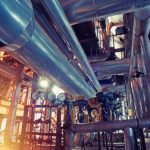Common Steam Piping Issues and How to Prevent Them
November 10, 2023 10:13 pm Leave your thoughts In industrial settings, steam piping is an essential component of numerous processes, including heating, power generation, and industrial cleaning. However, like any other piping system, steam piping is susceptible to a variety of issues that can impede its performance, compromise safety, and lead to costly repairs. To ensure the efficient and safe operation of steam piping systems, it is crucial to identify and address common piping issues proactively. In this blog post, we will discuss some of the most prevalent steam piping issues and provide preventive measures to mitigate their impact.
In industrial settings, steam piping is an essential component of numerous processes, including heating, power generation, and industrial cleaning. However, like any other piping system, steam piping is susceptible to a variety of issues that can impede its performance, compromise safety, and lead to costly repairs. To ensure the efficient and safe operation of steam piping systems, it is crucial to identify and address common piping issues proactively. In this blog post, we will discuss some of the most prevalent steam piping issues and provide preventive measures to mitigate their impact.
1. Corrosion:
Corrosion is one of the most common issues encountered in steam piping systems. It can lead to pipe thinning, leakage, and even catastrophic failures. Corrosion can occur due to factors such as the quality of steam, improper material selection, or inadequate insulation. To prevent corrosion, it is essential to choose the correct materials for steam piping. Stainless steel or corrosion-resistant alloys are commonly used to mitigate the effects of corrosion. Regular inspections and maintenance, including cleaning and passivation, can also help prevent and detect corrosion early on.
2. Water Hammer:
Water hammer refers to the loud banging or thumping noise caused by sudden changes in steam flow, typically resulting from abrupt valve closures. This phenomenon can cause severe damage to steam piping systems, including cracked pipes, loose fittings, and valve damage. To prevent water hammer, it is crucial to properly size piping and valves to match the flow requirements. Additionally, the installation of dampening devices, such as water hammer arrestors or pressure relief valves, can help absorb the sudden pressure surges and minimize the impact of water hammer events.
3. Pipe Erosion:
Pipe erosion occurs when high-velocity steam or condensate causes wearing away of the internal pipe surfaces. This can result in decreased pipe wall thickness, increased roughness, and compromised piping integrity. To prevent erosion, it is important to carefully design the steam piping system, considering factors such as adequate pipe sizing, velocity limits, and proper control of steam flow. Furthermore, fitting the pipes with erosion-resistant materials enables them to withstand the erosive effects of high-velocity steam or condensate.
4. Steam Trap Issues:
Steam traps are vital components of steam piping systems as they facilitate the prompt removal of condensate and ensure the uninterrupted flow of steam. Common issues with steam traps include steam loss, leaking traps, or malfunctioning mechanisms. Regular maintenance and inspection of steam traps are essential to prevent these issues. Conducting steam trap surveys, testing for trap functionality, and replacing faulty traps can significantly improve system efficiency and reduce energy losses.
5. Insulation Failure:
Proper insulation is crucial for steam piping systems to maintain efficient energy transfer and prevent condensation. Insulation failure can result from factors such as aging, physical damage, or improper installation. Inadequate insulation leads to heat loss, increased energy consumption, and potential safety hazards. To prevent insulation failure, it is essential to use high-quality insulation materials with appropriate thermal properties. Routine inspection and maintenance of insulation systems should also be carried out to identify and rectify any issues promptly.
6. Steam Leakage:
Steam leakage is not only a waste of energy but can also compromise the operational efficiency of a steam piping system. Common causes of steam leakage include faulty seals, loose fittings, or damaged valves. Regular inspection and maintenance are crucial for detecting and repairing steam leaks promptly. Tightening loose fittings, replacing damaged components, and using appropriate gaskets and sealing materials can help prevent steam leakage and optimize system performance.
Summary:
By understanding and addressing common steam piping issues proactively, industrial facilities can ensure the uninterrupted operation of their steam piping systems while maximizing efficiency and minimizing safety risks. Proper material selection, regular maintenance, and monitoring are vital in mitigating corrosion, water hammer, erosion, steam trap issues, insulation failure, and steam leakage. By implementing preventive measures, businesses can reduce maintenance costs, improve energy efficiency, and enhance the overall reliability of their steam piping systems.
Need Steel Fabricators in Hermiston, OR?
NW Metal Fabricators, Inc. is a family-owned business that has been servicing customers in Hermiston, Oregon since 1986. We have more than 100 years of experience in the food-processing industry and specialize in the custom production of storage bins, conveyors, catwalks, handrails, gates, storage tanks, water heater tanks, sanitary piping, steam piping, and trailer truck hitches. NW Metal Fabricators, Inc. is an accredited member of the local Chamber of Commerce. We are a dedicated business where quality always comes first. Our customers know that they can count on us to make sure that their products are hand-crafted to meet their specifications. Contact us today to learn more about what we can do for you!
Categorised in: Steam Piping Safety
This post was written by admin
